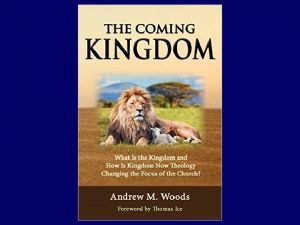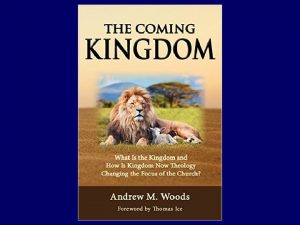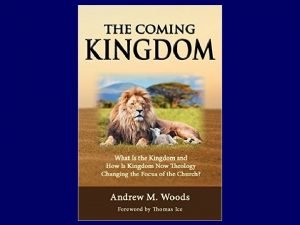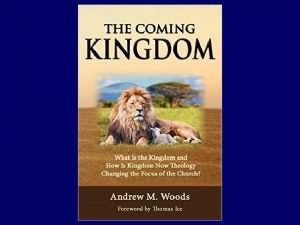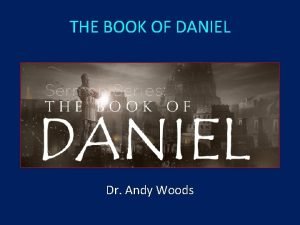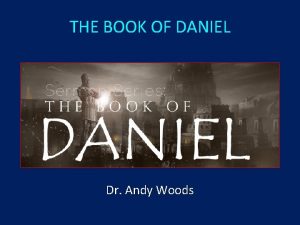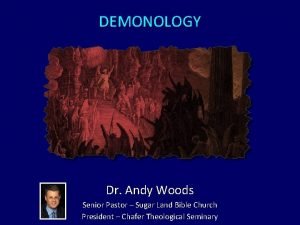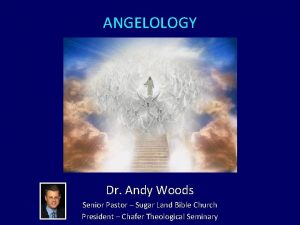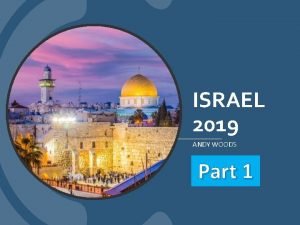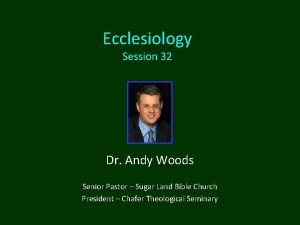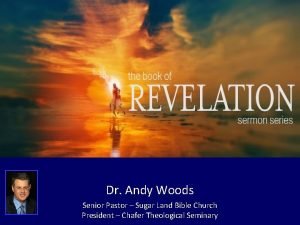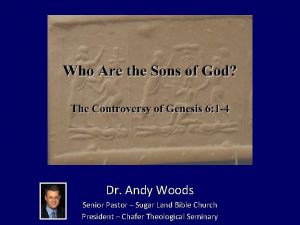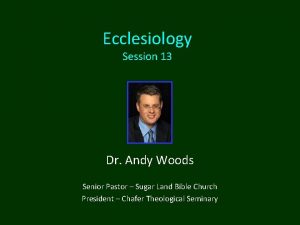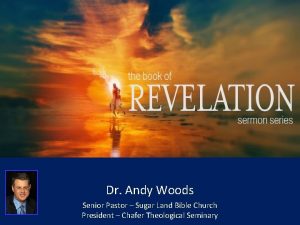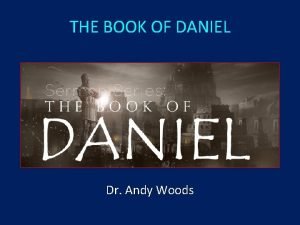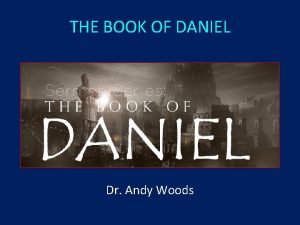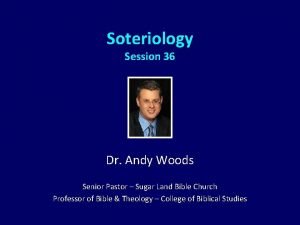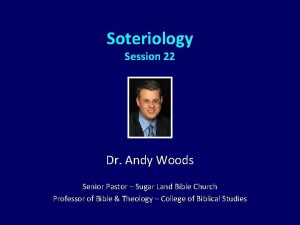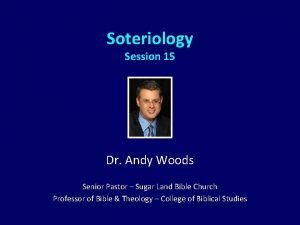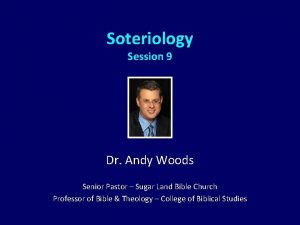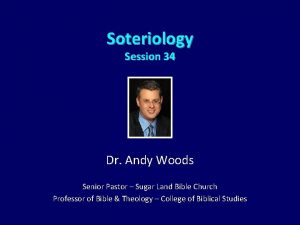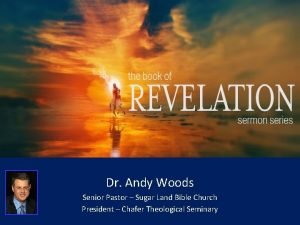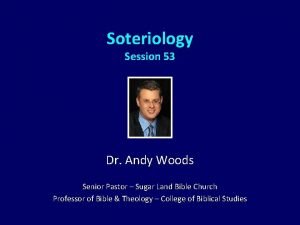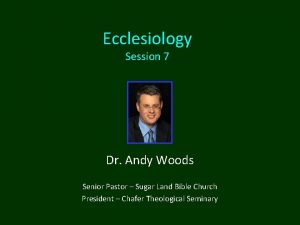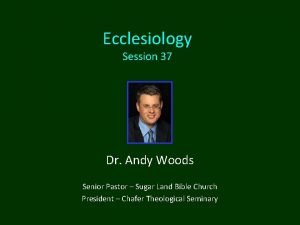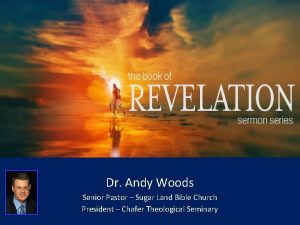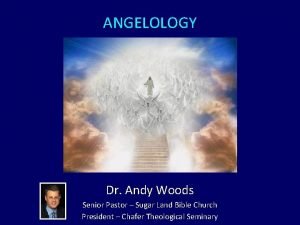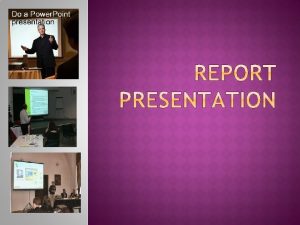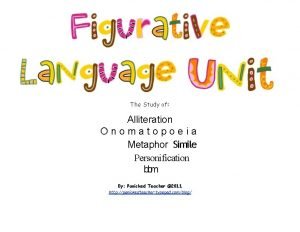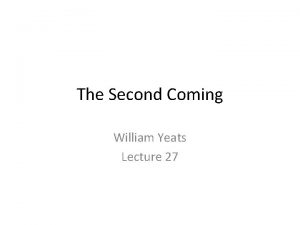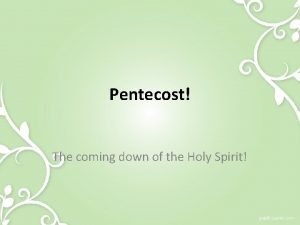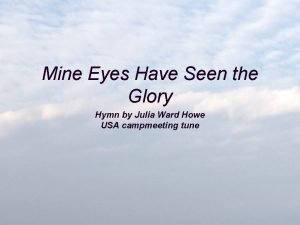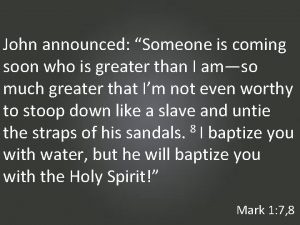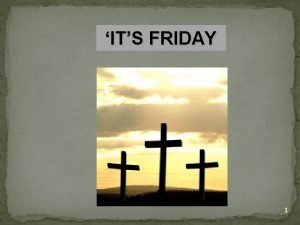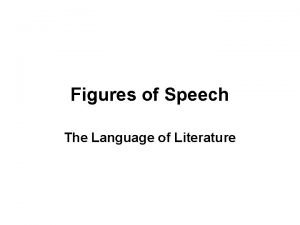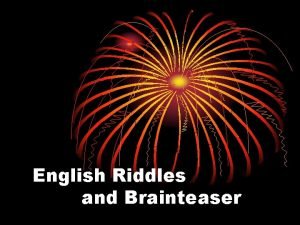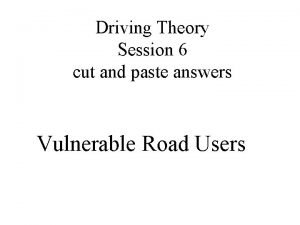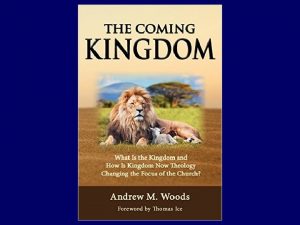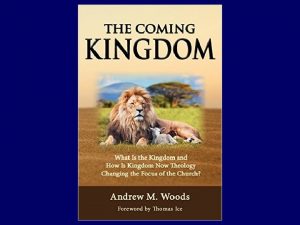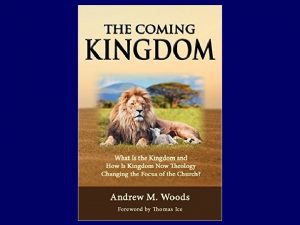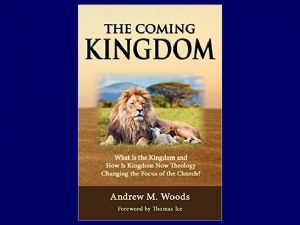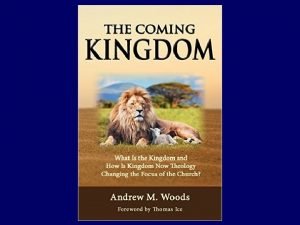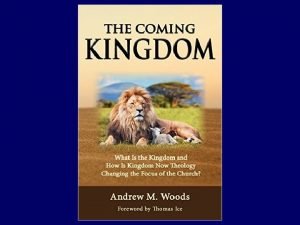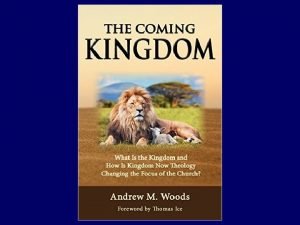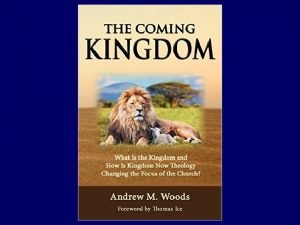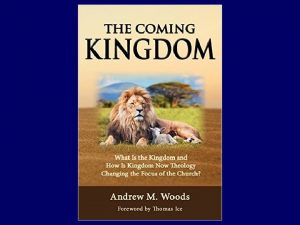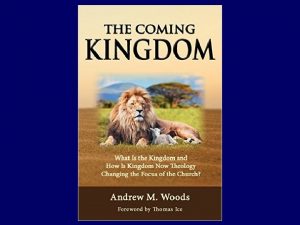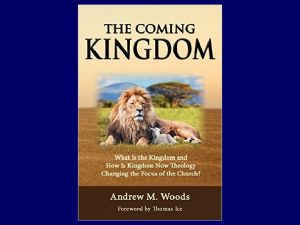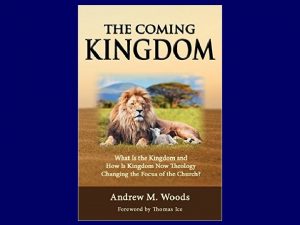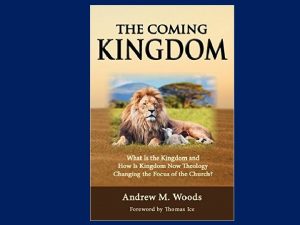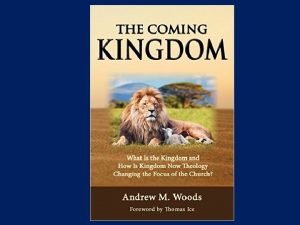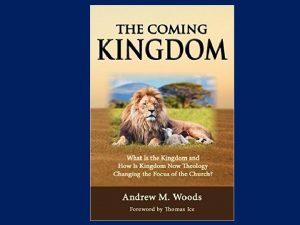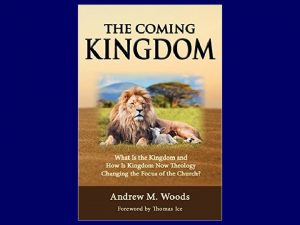The Coming Kingdom Chapter 9 Dr Andy Woods


























![“Mystery” Defined “In the N. T, it [mystērion] denotes, not the mysterious (as with “Mystery” Defined “In the N. T, it [mystērion] denotes, not the mysterious (as with](https://slidetodoc.com/presentation_image_h2/5154bb657a6c204546c5bb6e19dfdc6e/image-27.jpg)






































![The Prophetic Parables of Matthew Thirteen - A. W. Pink “[In Matthew 12] we The Prophetic Parables of Matthew Thirteen - A. W. Pink “[In Matthew 12] we](https://slidetodoc.com/presentation_image_h2/5154bb657a6c204546c5bb6e19dfdc6e/image-66.jpg)


![“Mystery” Defined “In the N. T, it [mystērion] denotes, not the mysterious (as with “Mystery” Defined “In the N. T, it [mystērion] denotes, not the mysterious (as with](https://slidetodoc.com/presentation_image_h2/5154bb657a6c204546c5bb6e19dfdc6e/image-69.jpg)





























- Slides: 98


The Coming Kingdom Chapter 9 Dr. Andy Woods Senior Pastor – Sugar Land Bible Church President – Chafer Theological Seminary

Kingdom Study Outline 1. What does the Bible Say About the Kingdom? 2. The Main Problem with Kingdom Now NT interpretations 3. Why do some believe that we are in the kingdom now? 4. Why does it matter?

Kingdom Study Outline 1. What does the Bible Say About the Kingdom? 2. The Main Problem with Kingdom Now NT interpretations 3. Why do some believe that we are in the kingdom now? 4. Why does it matter?

1. Kingdom Throughout the Bible 1. Eden 6. Old Testament Prophets 2. Abrahamic Covenant 7. Post exile 3. Mosaic Covenant 8. Offer of the King / Kingdom 4. Divided Kingdom 9. Rejection of the Offer 5. Times of the Gentiles 10. Interim Age

1. Kingdom Throughout the Bible 1. Eden 6. Old Testament Prophets 2. Abrahamic Covenant 7. Post exile 3. Mosaic Covenant 8. Offer of the King / Kingdom 4. Divided Kingdom 9. Rejection of the Offer 5. Times of the Gentiles 10. Interim Age

1. Kingdom Throughout the Bible 1. Eden 6. Old Testament Prophets 2. Abrahamic Covenant 7. Post exile 3. Mosaic Covenant 8. Offer of the King / Kingdom 4. Divided Kingdom 9. Rejection of the Offer 5. Times of the Gentiles 10. Interim Age

1. Kingdom Throughout the Bible 1. Eden 6. Old Testament Prophets 2. Abrahamic Covenant 7. Post exile 3. Mosaic Covenant 8. Offer of the King / Kingdom 4. Divided Kingdom 9. Rejection of the Offer 5. Times of the Gentiles 10. Interim Age

1. Kingdom Throughout the Bible 1. Eden 6. Old Testament Prophets 2. Abrahamic Covenant 7. Post exile 3. Mosaic Covenant 8. Offer of the King / Kingdom 4. Divided Kingdom 9. Rejection of the Offer 5. Times of the Gentiles 10. Interim Age

1. Kingdom Throughout the Bible 1. Eden 6. Old Testament Prophets 2. Abrahamic Covenant 7. Post exile 3. Mosaic Covenant 8. Offer of the King / Kingdom 4. Divided Kingdom 9. Rejection of the Offer 5. Times of the Gentiles 10. Interim Age

1. Kingdom Throughout the Bible 1. Eden 6. Old Testament Prophets 2. Abrahamic Covenant 7. Post exile 3. Mosaic Covenant 8. Offer of the King / Kingdom 4. Divided Kingdom 9. Rejection of the Offer 5. Times of the Gentiles 10. Interim Age

1. Kingdom Throughout the Bible 1. Eden 6. Old Testament Prophets 2. Abrahamic Covenant 7. Post exile 3. Mosaic Covenant 8. Offer of the King / Kingdom 4. Divided Kingdom 9. Rejection of the Offer 5. Times of the Gentiles 10. Interim Age

1. Kingdom Throughout the Bible 1. Eden 6. Old Testament Prophets 2. Abrahamic Covenant 7. Post exile 3. Mosaic Covenant 8. Offer of the King / Kingdom 4. Divided Kingdom 9. Rejection of the Offer 5. Times of the Gentiles 10. Interim Age

1. Kingdom Throughout the Bible 1. Eden 6. Old Testament Prophets 2. Abrahamic Covenant 7. Post exile 3. Mosaic Covenant 8. Offer of the King / Kingdom 4. Divided Kingdom 9. Rejection of the Offer 5. Times of the Gentiles 10. Interim Age

1. Kingdom Throughout the Bible 1. Eden 6. Old Testament Prophets 2. Abrahamic Covenant 7. Post exile 3. Mosaic Covenant 8. Offer of the King / Kingdom 4. Divided Kingdom 9. Rejection of the Offer 5. Times of the Gentiles 10. Interim Age

THE INTERIM AGE 1. The Inter-advent Age (Matt. 13) 2. The Church Age (Matt. 16: 18)

Five Preliminary Observations 1. An Authentic Age 2. An Age Caused by Israel’s Unbelief 3. A Mystery Age 4. A Priestly Age 5. An Important Age

Five Preliminary Observations 1. An Authentic Age 2. An Age Caused by Israel’s Unbelief 3. A Mystery Age 4. A Priestly Age 5. An Important Age

Luke 19: 11 (NASB) “While they were listening to these things, Jesus went on to tell a parable, because He was near Jerusalem, and they supposed that the kingdom of God was going to appear immediately. ”

Luke 19: 15 (NASB) “When he returned, after receiving the kingdom, he ordered that these slaves, to whom he had given the money, be called to him so that he might know what business they had done. ”

Five Preliminary Observations 1. An Authentic Age 2. An Age Caused by Israel’s Unbelief 3. A Mystery Age 4. A Priestly Age 5. An Important Age

Daniel 9: 26 (NASB) “So you are to know and discern that from the issuing of a decree to restore and rebuild Jerusalem until Messiah the Prince there will be seven weeks and sixty-two weeks; it will be built again, with plaza and moat, even in times of distress. 26 Then after the sixty-two weeks the Messiah will be cut off and have nothing, and the people of the prince who is to come will destroy the city and the sanctuary. And its end will come with a flood; even to the end there will be war; desolations are determined. ’”

“God not only knows beforehand the choice His creatures will make, but is Himself able to work in them both to will and to do of His own good pleasure. The Scriptures present many incidents which disclose the fact that the will of God is executed by men even when they have no conscious intention to do the will of God. . Was the death of Christ in danger of being abortive and all the types and prophecies respecting His death of being proved untrue until Pilate made his decision regarding that death? ” Lewis Sperry Chafer, vol. 5, Systematic Theology (Grand Rapids, MI: Kregel Publications, 1993), 347 -48.

Five Preliminary Observations 1. An Authentic Age 2. An Age Caused by Israel’s Unbelief 3. A Mystery Age 4. A Priestly Age 5. An Important Age

Matthew 13: 11 (NASB) Jesus answered them, “To you it has been granted to know the mysteries of the kingdom of heaven, but to them it has not been granted. ”

Ephesians 3: 9 (NASB) “and to bring to light what is the administration of the mystery which for ages has been hidden in God who created all things. ”
![Mystery Defined In the N T it mystērion denotes not the mysterious as with “Mystery” Defined “In the N. T, it [mystērion] denotes, not the mysterious (as with](https://slidetodoc.com/presentation_image_h2/5154bb657a6c204546c5bb6e19dfdc6e/image-27.jpg)
“Mystery” Defined “In the N. T, it [mystērion] denotes, not the mysterious (as with the Eng. word), but that which, being outside the range of unassisted natural apprehension, can be made known only by Divine revelation, and is made known in a manner and at a time appointed by God, and to those who are illumined by His Spirit. ” W. E. Vine, Merrill F. Unger, and William White, Vine's Complete Expository Dictionary of the Old and New Testament Words (Nashville: Nelson, 1996), 424.

Five Preliminary Observations 1. An Authentic Age 2. An Age Caused by Israel’s Unbelief 3. A Mystery Age 4. A Priestly Age 5. An Important Age

Christ’s Three Offices 1. Prophet (Matt. 4: 17) 2. Priest (Heb. 4: 15) 3. King (Isa. 9: 6 -7; Matt. 25: 31)

Christ’s Three Offices 1. Prophet (Matt. 4: 17) 2. Priest (Heb. 4: 15) 3. King (Isa. 9: 6 -7; Matt. 25: 31)

Daniel 9: 26 (NASB) “So you are to know and discern that from the issuing of a decree to restore and rebuild Jerusalem until Messiah the Prince there will be seven weeks and sixty-two weeks; it will be built again, with plaza and moat, even in times of distress. 26 Then after the sixty-two weeks the Messiah will be cut off and have nothing, and the people of the prince who is to come will destroy the city and the sanctuary. And its end will come with a flood; even to the end there will be war; desolations are determined. ’”

Revelation 3: 21 (NASB) “He who overcomes, I will grant to him to sit down with Me on My throne, as I also overcame and sat down with My Father on His throne. ”

Revelation 22: 1 (NASB) “Then he showed me a river of the water of life, clear as crystal, coming from the throne of God and of the Lamb. ”

Revelation 3: 21 in Progressive Dispensationalism “One may object that the throne at the right hand of God is not the Davidic throne, which is earthly. The objection might be raised by appealing to a text like Revelation 3: 21, where Jesus distinguishes between ‘my throne, ’ in which the overcomer will sit, and the Father’s throne, on which Jesus currently sits. The argument is made that the throne on which Jesus sits in Acts is the Father’s throne, not David’s…this throne of the lamb, set next to the Father, is alluded to again in Revelation 22: 1. This is the same throne that Jesus occupies in the consummation! He exercises Davidic rule now even as he will exercises it then. ” Darrell Bock, “The Reign of the Lord Christ, ” in Dispensationalism, Israel and the Church, ed. Craig Blaising and Darrell Bock (Grand Rapids: Zondervan, 1992), 50, 62.

Romans 16: 25 -26 (NASB) “Now to Him who is able to establish you according to my gospel and the preaching of Jesus Christ, according to the revelation of the mystery which has been kept secret for long ages past, 26 but now is manifested, and by the Scriptures of the prophets, prophets according to the commandment of the eternal God, has been made known to all the nations, leading to obedience of faith. ” 25

Romans 1: 2 -3 (NASB) “ 2 which He promised beforehand through His prophets in the holy Scriptures, 3 concerning His Son, who was born of a descendant of David according to the flesh. ”

ROMANS 1: 2 -3 ROMANS 16: 25 -26 Location Beginning End Function Introduction Doxology Mystery No Yes Davidic lineage Yes No “Holy” modifying “Scriptures” Yes No Definite article before “Scriptures” Yes No “Prophets” Noun Adjective “Prophets” Old Testament New Testament Scripture Old Testament NT “mysteries” (Rom. 11: 25 b) Absent Present “My Gospel”


Eternal State is Future n No Satan (Rev 20: 10) n No sea (Rev 21: 1) n No death, crying, or pain (Rev 21: 4) n No Sun (Rev 22: 5) n No Moon (Rev 21: 23) n No night (Rev 21: 25) n No evil (Rev 21: 27) n No curse (Rev 22: 23)

Revelation 12: 5 (NASB) “And she gave birth to a son, a male child, who is to rule all the nations with a rod of iron; and her child was caught up to God and to His throne. ”

John 17: 5 (NASB) “Now, Father, glorify Me together with Yourself, with the glory which I had with You before the world was. ”

Revelation 3: 7 (NASB) “And to the angel of the church in Philadelphia write: He who is holy, who is true, who has the key of David, who opens and no one will shut, and who shuts and no one opens, says this: …”

Revelation 5: 5 (NASB) and one of the elders said to me, “Stop weeping; behold, the Lion that is from the tribe of Judah, the Root of David, has overcome so as to open the book and its seven seals. ”

Revelation 22: 16 (NASB) “I, Jesus, have sent My angel to testify to you these things for the churches. I am the root and the descendant of David, the bright morning star. ”

Hebrews 7: 3 (NASB) “Without father, without mother, without genealogy, having neither beginning of days nor end of life, but made like the Son of God, he remains a priest perpetually. ”

“Similarly, the earthly kingdom that according to the Scriptures had its origin in the covenant made to David, which is mundane and literal in its original form and equally as mundane and literal in uncounted references to it in all subsequent Scriptures which trace it on to its consummation, is by theological legerdemain metamorphosed into a spiritual monstrosity in which an absent King seated on His Father’s throne in heaven is accepted in lieu of theocratic monarch of David’s line seated on David’s throne in Jerusalem. ” Lewis Sperry Chafer, vol. 5, Systematic Theology (Grand Rapids, MI: Kregel Publications, 1993), 315.

Five Preliminary Observations 1. An Authentic Age 2. An Age Caused by Israel’s Unbelief 3. A Mystery Age 4. A Priestly Age 5. An Important Age

Ephesians 3: 11 (NASB) “This was in accordance with the eternal purpose which He carried out in Christ Jesus our Lord. ”


The Church is not “Plan B” “In almost 35 years since I have become a dispensationalist, I have never heard nor read of a dispensationalist teaching a plan B scenario. Yet opponents often present this straw man in their statement of what we supposedly believe. We believe that God’s single plan has always included the Church, but He did not reveal the church age part of the plan in the Old Testament. . Paul states specifically that the church age ‘was in accordance with the eternal purpose which He carried out in Christ Jesus our Lord’ (verse 11). This is why dispensationalists have never taught the so-called plan A and plan B theory that critics suppose we hold. Dispensationalists have always taught that there is a single plan carried out in stages. ” Thomas Ice, “The Uniqueness of the Church, ” Pre-Trib Perspectives 8, no. 6 (September 2003): 4.


Conclusion

Five Preliminary Observations 1. An Authentic Age 2. An Age Caused by Israel’s Unbelief 3. A Mystery Age 4. A Priestly Age 5. An Important Age

The Coming Kingdom Chapter 10 Dr. Andy Woods Senior Pastor – Sugar Land Bible Church President – Chafer Theological Seminary

1. Kingdom Throughout the Bible 1. Eden 6. Old Testament Prophets 2. Abrahamic Covenant 7. Post exile 3. Mosaic Covenant 8. Offer of the King / Kingdom 4. Divided Kingdom 9. Rejection of the Offer 5. Times of the Gentiles 10. Interim Age

1. Kingdom Throughout the Bible 11. Kingdom Mysteries 15. Kingdom Establishment 12. Church 16. Eternal State 13. Re-offer of the King/Kingdom 17. Testimony of Early Church History 14. Transfer of Kingdom Authority

1. Kingdom Throughout the Bible 11. Kingdom Mysteries 15. Kingdom Establishment 12. Church 16. Eternal State 13. Re-offer of the King/Kingdom 17. Testimony of Early Church History 14. Transfer of Kingdom Authority

THE INTERIM AGE 1. The Inter-advent Age (Matt. 13) 2. The Church Age (Matt. 16: 18)

THE INTERIM AGE 1. The Inter-advent Age (Matt. 13) 2. The Church Age (Matt. 16: 18)

Background to the Matthew 13 Parables 1. Their position in Matthew’s Gospel 2. Their mystery nature 3. They do not represent the kingdom 4. They represent course of the present age 5. The experiences of the kingdom’s sons 6. They are taught in parables 7. Their two-fold division

Background to the Matthew 13 Parables 1. Their position in Matthew’s Gospel 2. Their mystery nature 3. They do not represent the kingdom 4. They represent course of the present age 5. The experiences of the kingdom’s sons 6. They are taught in parables 7. Their two-fold division

Matthew 12: 24 (NASB) “But when the Pharisees heard this, they said, “This man casts out demons only by Beelzebul the ruler of the demons. ”

Transition from Public to Private Ministry Scripture Focus Public Matt. 1– 12 Nation Miracles Proof to nation Offer Teaching Interim program Crucifixion; Resurrection Prominent Discourse Not mentioned (4: 17) Private Matt. 13– 28 Remnant Training for remnant Disappears Parabolic Prominent (16: 21)

Matthew Outline Pedigree of the king (1– 2) u Preparation of the king (3– 4) Pedagogy of the king (5– 7) • Power of the king (8– 9) – Program of the king (10) – Progressive rejection of the king (11– 12) – Preparation of the king’s disciples (13– 20) • Presentation & rejection of the king (21– 23) t Prophecies of the king (24– 25) t u Passion of the king (26– 27) Proof of the king (28)

Matthew Outline Pedigree of the king (1– 2) u Preparation of the king (3– 4) Pedagogy of the king (5– 7) • Power of the king (8– 9) – Program of the king (10) – Progressive rejection of the king (11– 12) – Preparation of the king’s disciples (13– 20) • Presentation & rejection of the king (21– 23) t Prophecies of the king (24– 25) t u Passion of the king (26– 27) Proof of the king (28)
![The Prophetic Parables of Matthew Thirteen A W Pink In Matthew 12 we The Prophetic Parables of Matthew Thirteen - A. W. Pink “[In Matthew 12] we](https://slidetodoc.com/presentation_image_h2/5154bb657a6c204546c5bb6e19dfdc6e/image-66.jpg)
The Prophetic Parables of Matthew Thirteen - A. W. Pink “[In Matthew 12] we are told, ‘But when the Pharisees heard it, they said, This fellow doth not cast out demons, but by Beelzebub the prince of the demons’—there they committed the sin for which there was no forgiveness. Following our Lord’s sentence upon the Pharisees for their unpardonable blasphemy, we are next told, ‘Then certain of the scribes and the Pharisees answered, Master, we would see a sign from Thee’ (v. 38). His response was that the only sign which should be given to that evil and unfaithful generation should be that of ‘the sign of the prophet Jonah’—i. e. , that after three days in the place of death the Servant of God should come forth and go unto the Gentiles. Following this, the Lord solemnly pronounced the coming judgment of Heaven upon that wicked generation, so that their last state should be worse than the first (vv. 43– 45). . ” A. W. Pink (2005). The Prophetic Parables of Matthew Thirteen. Bellingham, WA: Logos Bible Software.

The Prophetic Parables of Matthew Thirteen - A. W. Pink “The parables of this chapter [Matthew 13] were spoken by Christ ‘the same day’ as when the Pharisees had taken council together to destroy Him, as when they had committed the unpardonable sin, as when He had pronounced solemn judgment upon the Nation, and as when He had severed the fleshly ties which united Him to the Jews and had intimated that henceforth there should be a people united to Him by spiritual bonds. Thus the relation between Matthew 12 and Matthew 13 is that of cause to effect; in other words, Matthew 12 makes known the cause which led up to Christ’s acting as He did in the thirteenth chapter: that cause was Israel’s rejection of their King and His rejection of them. His action in Matthew 13: 1 was indicative of a great dispensational crisis, it was an anticipation of what is found developed at length in the books of Acts—God, temporarily, turning away from the Jews and turning unto the Gentiles. ” A. W. Pink (2005). The Prophetic Parables of Matthew Thirteen. Bellingham, WA: Logos Bible Software.

Background to the Matthew 13 Parables 1. Their position in Matthew’s Gospel 2. Their mystery nature 3. They do not represent the kingdom 4. They represent course of the present age 5. The experiences of the kingdom’s sons 6. They are taught in parables 7. Their two-fold division
![Mystery Defined In the N T it mystērion denotes not the mysterious as with “Mystery” Defined “In the N. T, it [mystērion] denotes, not the mysterious (as with](https://slidetodoc.com/presentation_image_h2/5154bb657a6c204546c5bb6e19dfdc6e/image-69.jpg)
“Mystery” Defined “In the N. T, it [mystērion] denotes, not the mysterious (as with the Eng. word), but that which, being outside the range of unassisted natural apprehension, can be made known only by Divine revelation, and is made known in a manner and at a time appointed by God, and to those who are illumined by His Spirit. ” W. E. Vine, Merrill F. Unger, and William White, Vine's Complete Expository Dictionary of the Old and New Testament Words (Nashville: Nelson, 1996), 424.

Matthew 13: 11 (NASB) Jesus answered them, “To you it has been granted to know the mysteries of the kingdom of heaven, but to them it has not been granted. ”

Matthew 13: 16 -17 (NASB) “But blessed are your eyes, because they see; and your ears, because they hear. 17 For truly I say to you that many prophets and righteous men desired to see what you see, and did not see it, and to hear what you hear, and did not hear it. ”

Matthew 13: 35 (NASB) “This was to fulfill what was spoken through the prophet: ‘I WILL OPEN MY MOUTH IN PARABLES; I will utter things hidden since the foundation of the world. ’”

The Prophetic Parables of Matthew Thirteen - A. W. Pink “The eleventh verse of Matthew 13 supplies yet another key, in the word “mysteries of the kingdom of heaven. ” In Scripture the term “mystery” signifies a Divine secret made known by the Holy Spirit. This is confirmed by what is told us in verse 35, namely, that Christ was here uttering “things which have been kept secret from the foundation of the world. ” Thus, in these parables, Christ was making known that which was outside the scope of O. T. prediction, something which God had not made known to Israel through the prophets. This needs to be carefully noted, for it refutes the popular interpretation of these parables. ” A. W. Pink (2005). The Prophetic Parables of Matthew Thirteen. Bellingham, WA: Logos Bible Software.

Background to the Matthew 13 Parables 1. Their position in Matthew’s Gospel 2. Their mystery nature 3. They do not represent the kingdom 4. They represent course of the present age 5. The experiences of the kingdom’s sons 6. They are taught in parables 7. Their two-fold division

The Prophetic Parables of Matthew Thirteen - A. W. Pink “There are many who regard the parables of Matthew 13 as containing predictions of the ushering in of the Millennium: those of the Mustard-tree and the Leaven are regarded as being parallel with the promise that “the knowledge of the glory of the Lord shall cover the earth as the waters cover the sea. ” But that statement is found in Isaiah 11: 9: that was no “secret” in O. T. times! Therefore, none of the parables in Matthew 13 can be treating of the same subject as Isaiah 11: 9, or what is stated in verse 35 would not be true. No; Matthew 13 deals with something nowhere revealed in the O. T. ; it is an entirely new revelation. ” A. W. Pink (2005). The Prophetic Parables of Matthew Thirteen. Bellingham, WA: Logos Bible Software.

Background to the Matthew 13 Parables 1. Their position in Matthew’s Gospel 2. Their mystery nature 3. They do not represent the kingdom 4. They represent course of the present age 5. The experiences of the kingdom’s sons 6. They are taught in parables 7. Their two-fold division

Matthew 13 Parables n n n n Sower (13: 1 -9, 18 -23) Wheat and tares (13: 24 -30, 36 -43) Mustard seed (13: 31 -32) Leaven (13: 33) Earthen treasure (13: 44) Pearl of great price (13: 45 -46) Dragnet (13: 47 -50) Householder (13: 51 -52)

Background to the Matthew 13 Parables 1. Their position in Matthew’s Gospel 2. Their mystery nature 3. They do not represent the kingdom 4. They represent course of the present age 5. The experiences of the kingdom’s sons 6. They are taught in parables 7. Their two-fold division

Matthew 13: 38 (NASB) “and the field is the world; and as for the good seed, these are the sons of the kingdom; kingdom and the tares are the sons of the evil one. ”

Galatians 4: 7 (NASB) “Therefore you are no longer a slave, but a son; and if a son, then an heir through God. ”

Background to the Matthew 13 Parables 1. Their position in Matthew’s Gospel 2. Their mystery nature 3. They do not represent the kingdom 4. They represent course of the present age 5. The experiences of the kingdom’s sons 6. They are taught in parables 7. Their two-fold division


Why Did Jesus Teach in Parables in Matthew 13? 1. To fulfill prophecy (Matt. 13: 34 -25) 2. To conceal and reveal (Matt. 13: 16 -17)

Why Did Jesus Teach in Parables in Matthew 13? 1. To fulfill prophecy (Matt. 13: 34 -25) 2. To conceal and reveal (Matt. 13: 16 -17)

Matthew 13: 35 (NASB) “This was to fulfill what was spoken through the prophet: ‘I WILL OPEN MY MOUTH IN PARABLES; I WILL UTTER THINGS HIDDEN SINCE THE FOUNDATION OF THE WORLD. ’”

Why Did Jesus Teach in Parables in Matthew 13? 1. To fulfill prophecy (Matt. 13: 34 -25) 2. To conceal and reveal (Matt. 13: 16 -17)

Matthew 12: 24 (NASB) “But when the Pharisees heard this, they said, “This man casts out demons only by Beelzebul the ruler of the demons. ”

Transition from Public to Private Ministry Scripture Focus Public Matt. 1– 12 Nation Miracles Proof to nation Offer Teaching Interim program Crucifixion; Resurrection Prominent Discourse Not mentioned (4: 17) Private Matt. 13– 28 Remnant Training for remnant Disappears Parabolic Prominent (16: 21)

Matthew 11: 20 -24 (NASB) “Then He began to denounce the cities in which most of His miracles were done, because they did not repent. 21 ’Woe to you, Chorazin! Woe to you, Bethsaida! For if the miracles had occurred in Tyre and Sidon which occurred in you, they would have repented long ago in sackcloth and ashes. 22 Nevertheless I say to you, it will be more tolerable for Tyre and Sidon in the day of judgment than for you. ’”

Matthew 11: 20 -24 (NASB) “ 23 And you, Capernaum, will not be exalted to heaven, will you? You will descend to Hades; for if the miracles had occurred in Sodom which occurred in you, it would have remained to this day. 24 Nevertheless I say to you that it will be more tolerable for the land of Sodom in the day of judgment, than for you. ”

Matthew 13: 16 -17 (NASB) “But blessed are your eyes, because they see; and your ears, because they hear. 17 For truly I say to you that many prophets and righteous men desired to see what you see, and did not see it, and to hear what you hear, and did not hear it. ”

Ephesians 2: 20 (NASB) “having been built on the foundation of the apostles and prophets, Christ Jesus Himself being the corner stone. ”

Background to the Matthew 13 Parables 1. Their position in Matthew’s Gospel 2. Their mystery nature 3. They do not represent the kingdom 4. They represent course of the present age 5. The experiences of the kingdom’s sons 6. They are taught in parables 7. Their two-fold division

Matthew 13: 1 -2 (NASB) “That day Jesus went out of the house and was sitting by the sea. 2 And large crowds gathered to Him, so He got into a boat and sat down, and the whole crowd was standing on the beach. ”

Matthew 13: 36 (NASB) “Then He left the crowds and went into the house. And His disciples came to Him and said, ‘Explain to us the parable of the tares of the field. ’”

Matthew 13 Parables n n Public parables (13: 1 -2) u Sower (13: 1 -9, 18 -23) u Wheat and tares (13: 24 -30, 36 -43) u Mustard seed (13: 31 -32) u Leaven (13: 33) Private parables (13: 36) u Earthen treasure (13: 44) u Pearl of great price (13: 45 -46) u Dragnet (13: 47 -50) u Householder (13: 51 -52)

Conclusion

Background to the Matthew 13 Parables 1. Their position in Matthew’s Gospel 2. Their mystery nature 3. They do not represent the kingdom 4. They represent course of the present age 5. The experiences of the kingdom’s sons 6. They are taught in parables 7. Their two-fold division
 Andy woods the coming kingdom
Andy woods the coming kingdom The coming kingdom andy woods
The coming kingdom andy woods Major prophets
Major prophets Andy woods the coming kingdom
Andy woods the coming kingdom Old kingdom middle kingdom new kingdom
Old kingdom middle kingdom new kingdom Old kingdom middle kingdom new kingdom
Old kingdom middle kingdom new kingdom Youtube
Youtube Old kingdom middle kingdom new kingdom
Old kingdom middle kingdom new kingdom Andy woods daniel
Andy woods daniel Ptolemy
Ptolemy Pastor andy wood
Pastor andy wood Dr. andy woods
Dr. andy woods Andy woods ezekiel
Andy woods ezekiel Pastor andy woods
Pastor andy woods Dr andy woods sugarland bible church
Dr andy woods sugarland bible church Andy woods genesis
Andy woods genesis Andy woods zechariah
Andy woods zechariah Babylon's fall
Babylon's fall David rockefeller memoirs page 405
David rockefeller memoirs page 405 Andy woods daniel
Andy woods daniel Andy woods pastor
Andy woods pastor Andy woods pastor
Andy woods pastor Andy woods pastor
Andy woods pastor Pastor andy woods wife
Pastor andy woods wife John 1:12 nasb
John 1:12 nasb Sugarland bible church andy woods
Sugarland bible church andy woods Dr andy woods sugarland bible church
Dr andy woods sugarland bible church Andy woods soteriology
Andy woods soteriology Andy woods pastor age
Andy woods pastor age Pastor andy woods
Pastor andy woods Sugarland bible church
Sugarland bible church Andy woods angelology
Andy woods angelology Protista mobility
Protista mobility Plantae
Plantae Kingdom of protist
Kingdom of protist Trichomoniasis
Trichomoniasis Chapter 2 lesson 2 uniting for independence answer key
Chapter 2 lesson 2 uniting for independence answer key Hát kết hợp bộ gõ cơ thể
Hát kết hợp bộ gõ cơ thể Slidetodoc
Slidetodoc Bổ thể
Bổ thể Tỉ lệ cơ thể trẻ em
Tỉ lệ cơ thể trẻ em Gấu đi như thế nào
Gấu đi như thế nào Chụp phim tư thế worms-breton
Chụp phim tư thế worms-breton Hát lên người ơi alleluia
Hát lên người ơi alleluia Các môn thể thao bắt đầu bằng từ đua
Các môn thể thao bắt đầu bằng từ đua Thế nào là hệ số cao nhất
Thế nào là hệ số cao nhất Các châu lục và đại dương trên thế giới
Các châu lục và đại dương trên thế giới Công của trọng lực
Công của trọng lực Trời xanh đây là của chúng ta thể thơ
Trời xanh đây là của chúng ta thể thơ Cách giải mật thư tọa độ
Cách giải mật thư tọa độ 101012 bằng
101012 bằng Phản ứng thế ankan
Phản ứng thế ankan Các châu lục và đại dương trên thế giới
Các châu lục và đại dương trên thế giới Thơ thất ngôn tứ tuyệt đường luật
Thơ thất ngôn tứ tuyệt đường luật Quá trình desamine hóa có thể tạo ra
Quá trình desamine hóa có thể tạo ra Một số thể thơ truyền thống
Một số thể thơ truyền thống Cái miệng xinh xinh thế chỉ nói điều hay thôi
Cái miệng xinh xinh thế chỉ nói điều hay thôi Vẽ hình chiếu vuông góc của vật thể sau
Vẽ hình chiếu vuông góc của vật thể sau Nguyên nhân của sự mỏi cơ sinh 8
Nguyên nhân của sự mỏi cơ sinh 8 đặc điểm cơ thể của người tối cổ
đặc điểm cơ thể của người tối cổ Ví dụ giọng cùng tên
Ví dụ giọng cùng tên Vẽ hình chiếu đứng bằng cạnh của vật thể
Vẽ hình chiếu đứng bằng cạnh của vật thể Phối cảnh
Phối cảnh Thẻ vin
Thẻ vin đại từ thay thế
đại từ thay thế điện thế nghỉ
điện thế nghỉ Tư thế ngồi viết
Tư thế ngồi viết Diễn thế sinh thái là
Diễn thế sinh thái là Các loại đột biến cấu trúc nhiễm sắc thể
Các loại đột biến cấu trúc nhiễm sắc thể Bảng số nguyên tố lớn hơn 1000
Bảng số nguyên tố lớn hơn 1000 Tư thế ngồi viết
Tư thế ngồi viết Lời thề hippocrates
Lời thề hippocrates Thiếu nhi thế giới liên hoan
Thiếu nhi thế giới liên hoan ưu thế lai là gì
ưu thế lai là gì Hổ đẻ mỗi lứa mấy con
Hổ đẻ mỗi lứa mấy con Sự nuôi và dạy con của hổ
Sự nuôi và dạy con của hổ Sơ đồ cơ thể người
Sơ đồ cơ thể người Từ ngữ thể hiện lòng nhân hậu
Từ ngữ thể hiện lòng nhân hậu Thế nào là mạng điện lắp đặt kiểu nổi
Thế nào là mạng điện lắp đặt kiểu nổi Kingdom chapter 722
Kingdom chapter 722 Coming down the pike
Coming down the pike Thank you images
Thank you images Trees philip larkin
Trees philip larkin Personification examples
Personification examples The selfish giant every afternoon
The selfish giant every afternoon When was the second coming published
When was the second coming published West side story tritone
West side story tritone Coming together stage
Coming together stage Coming down of the holy spirit
Coming down of the holy spirit Mine eyes hath seen the glory
Mine eyes hath seen the glory People media value
People media value John announced
John announced Jesus is coming soon revelation
Jesus is coming soon revelation Sundays coming
Sundays coming I lift my hands to the coming king lyrics
I lift my hands to the coming king lyrics Philip larkin trees
Philip larkin trees What is always coming but never arrives
What is always coming but never arrives Why should you allow extra room
Why should you allow extra room Coming of age themes
Coming of age themes
